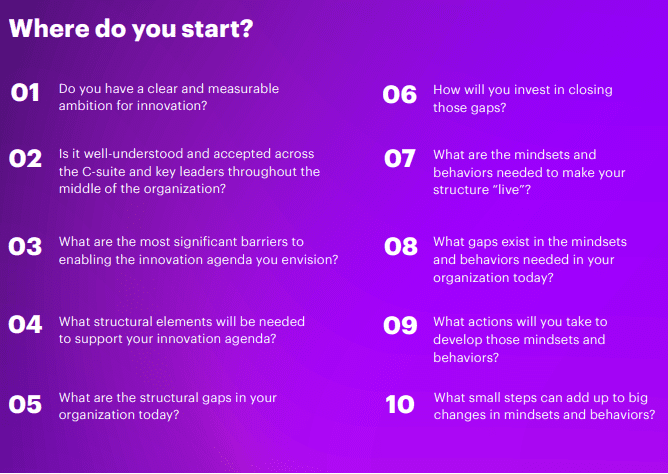Creating and fostering a culture of innovation is a critical business imperative. The impact of the Covid-19 pandemic on reshaping the workplace and humanizing the workforce has accelerated this need. Groundbreaking research from our new report, “Innovation Unleashed,” provides empirical evidence underscoring a direct correlation between a company’s innovation culture and its performance.
The idea of innovation structures (processes, technologies, and resources) has received much attention of late. In our recent global survey of 1,000 C-level executives, 82% said they believe that if they provide the suitable structures to support innovation, then an innovation culture—and the rewards it brings—will follow. However, such moves have often proven disappointing. They do well as individual units, yet the company finds that it cannot replicate these results across the organization; a common example is “proof-of-concept factories” or “innovation incubators” that fail to scale beyond a few successes.

To find out why, we homed in on 237 companies that have strong innovation cultures and the performance to prove it and compared them against 900 companies we surveyed. We found that while innovation structures are indeed important, leading companies augment their structures with the right innovation practices. They create what we call an “Innovation Value Flywheel” (Figure 1), a virtuous cycle of innovation structures, mindsets and behaviors that work together to hardwire the organization for innovation. Working in unison, they fuel an innovation culture that helps companies realize a robust return on their innovation investments, develop effective new ways of working, and drive growth and scale that enable strong financial performance.
We found that across industries, companies with strong innovation cultures (“Pacesetters”) consistently outperformed those without (“Stragglers”) even through the first year of the pandemic. On average, Pacesetters grew revenue 6.5 times faster than peers during 2018–20. Pacesetters also enjoyed clear advantages over Stragglers on measures such as better ecosystem partnerships (23% more) and greater pace of scaling innovation (26% faster) and access to specialized talent (22% more).
Our research also reveals an innovation gap—while 63% of 1,000 C-Suite executives surveyed agree that building a strong innovation culture is a growth driver, only 20% believe that their company today has the kind of culture it takes to support the ongoing innovation needed to thrive.
To better understand how to cross this precipice, our team undertook first-of-its-kind research using artificial intelligence and machine learning. We analyzed 210 specific business traits, grouping them into five categories to identify those that drive financial performance. These traits were then tested across 900 companies surveyed to build an innovation scorecard.
The research uncovered six actions leaders can take now to create a sustained culture of innovation.
1. Start from the top: Leaders must be role models for the desired mindsets.
Travelers, an insurance company founded 165 years ago, anticipated significant disruptive changes in data, technology, and consumer expectations. To respond to this, Alan Schnitzer, Chairman and CEO of The Travelers Companies, outlined a companywide “Perform and Transform” mandate. This involved engaging leaders on the practice and mindset of innovation, training people on driving experimentation at scale, and building a network of “Innovation Evangelists” who champion innovation across the business. To bolster and galvanize innovation mindsets, leaders host regular “Innovation Jams”, where people from all businesses and functions collaborate to ideate against future challenges and opportunities. The Jams typically attract hundreds of employees and, to date, have led to several in-market solutions and 30 patent applications.
2. Address the frozen middle: Bring other leaders on board and inspire them to lead the change.
Developing an innovation culture is not just the job of a company’s leaders. Innovation mindsets and behaviors must permeate the organization. Top leaders need to ensure that direct reports become innovation ambassadors. As part of efforts to expand membership, AARP, an advocacy organization for individuals aged 50 and over, realized it needed to foster a more robust innovation culture among its employees. This involved encouraging leaders to create “listening rooms”, where employees could discover the daily joys and challenges of AARP members, as expressed in submitted videos and quotes. AARP also developed an innovation lab where employees could prototype and bring novel ideas to life and build strategic partnerships with various start-ups and technology firms, thus helping thaw the frozen middle.
3. Make it simple and practical: Provide clear examples of small ways to activate behaviors in the day-to-day.
Successful leaders are potent storytellers who ensure employees understand and commit to the innovation ambition. A leading pharmaceutical giant’s simple and practical innovation culture was a catalyst and leading factor to breakthroughs that produced a Covid-19 vaccine in record time. The company’s “Dare-to-Try” initiative trained more than 100,000 employees in various innovation-positive tools and behaviors, including: breakthrough thinking, thoughtful risk-taking, and rapid experimentation. In just a year following the launch, more than 250 high-potential innovation proposals were funded—proposals that would have otherwise never been developed.
4. Leverage experimentation: Empower leaders to try out new things and witness the impact firsthand, which will build belief over time.
A very successful example comes from a leading technology company that drives innovation by creating “more at-bats per unit of time and money than anyone else”, according to the former CEO. This tech leader understands that an unavoidable cost of innovation is frequent failure and does not penalize or stigmatize efforts (and employees) that fail. Instead, the company rewards experimentation and risk-taking (“at bats”) in not only its core product and tech businesses but also in sales divisions and numerous support functions.
5. Create envy: Share stories of success widely across the organization, giving all employees practical tips on activating new mindsets.
Innovation should be democratized and not just be the purview of the innovation or R&D team. Despite having a long history of successful innovation, a leading consumer packaged goods company lost market share in many of its popular product lines. To remedy the situation, the company doubled down on investing even more in its R&D labs to develop eye-catching new products. However, while such efforts did boost innovation in some areas, they failed to revive the company’s overall fortunes. One reason: The company did not create envy by sharing stories. The enhanced innovation capabilities remained siloed in R&D, without making other units—from procurement and sourcing to finance and marketing—more innovative.
6. Reinforce the mindsets: Embed mindset into employee training and leadership assessments.
The strategy and action plan that a leading life sciences company used provides an ideal example of how to actively reinforce innovation mindsets. This involved training team members companywide on how to build stronger bonds of empathy with patients and physicians as well as how to become more agile and receptive to new ways of thinking. The payoff was better customer service and improved market offerings. Conducting “empathy exercises” led to a greater emphasis of patients’ varied needs when designing products. Increased employee agility led to greater use of prototyping, which allowed the company to bring more relevant solutions to market. The leaders reinforced the innovation mindsets by bravely embodying the change they wanted to see in the organization.
Building and maintaining an innovation culture is crucial, but often elusive. These six actions, when working in unison, will help create a virtuous cycle of structures, mindsets, and behaviors that hardwire an organization for innovation to thrive. When it comes to innovation, leaders may differ on their approach, but most agree they are constantly seeking new ways for innovation to be unleashed.










